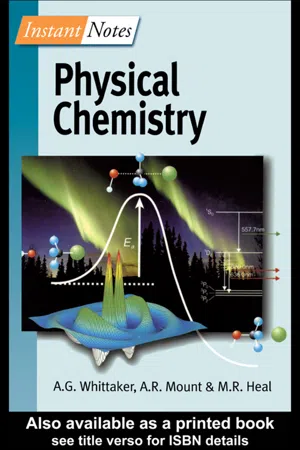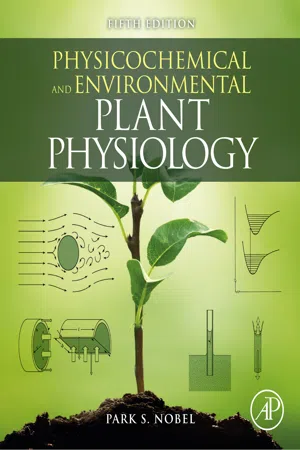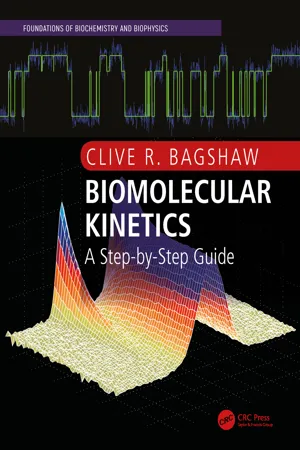Free Energy
Free energy in chemistry refers to the energy available to do work in a system. It is the energy that is available to drive chemical reactions and processes. Free energy is a measure of the spontaneity of a reaction, with a negative change in free energy indicating a spontaneous process.
7 Key excerpts on "Free Energy"
- Kevin Reel, Derrick C. Wood, Scott A. Best(Authors)
- 2014(Publication Date)
- Research & Education Association(Publisher)
...Free Energy is the energy available to do work, and takes the enthalpy and entropy of a reaction into account. If ΔG is negative, the reaction will be spontaneous; positive ΔG values mean that the reaction is nonspontaneous; and when ΔG = 0, the system is at equilibrium—meaning there is no preference. The Gibbs Free Energy value is related to the enthalpy and entropy according to the Gibbs-Helmholtz equation: Alternatively, the Gibbs Free Energy value can be calculated from Free Energy of formation values (ΔG f °) acquired under standard conditions through the summation equation: EXAMPLE: Using the following values, determine whether or not the burning of sugar (C 12 H 22 O 11) will be a spontaneous process. SOLUTION: Because the units are not matching up, the ΔS° should be converted to kJ/mol. The Gibbs Free Energy is calculated using the Gibbs-Helmholtz equation, using the temperature of 298 K because the data is for standard conditions. Because the ΔG° is negative, this reaction is spontaneous. TEST TIP Make sure the units are matching up when plugging into the Gibbs equation, which will likely require you to convert the temperature into Kelvin and the ΔS° in kJ/mol K. Predicting Reaction Spontaneity On the AP Chemistry exam, you may be asked to predict the spontaneity of a reaction based solely on qualitative determinations. You should familiarize yourself with Table 10.1, which describes the possible scenarios for enthalpy, entropy, and Free Energy based on the signs of ΔH, ΔS, and ΔG and the equation: Δ G = Δ H – T Δ S Table 10.1. Reaction Spontaneity: Possible Scenarios for Enthalpy, Entropy, and Free Energy Table 10.2. Thermo Signs and Symbols Summary Sign and Symbol Meaning –ΔH Exothermic; heat given off +ΔH Endothermic; heat absorbed –ΔS Decrease entropy; more organized +ΔS Increase entropy; more random/disordered –ΔG Spontaneous +ΔG Nonspontaneous...
- eBook - ePub
- Gavin Whittaker, Andy Mount, Matthew Heal(Authors)
- 2000(Publication Date)
- Taylor & Francis(Publisher)
...The Free Energy change represents the maximum amount of work, other than volume expansion work, which may be obtained from a process. Free Energy and spontaneity ∆ G is negative for a spontaneous process. An exothermic reaction (∆ H >0) with a positive entropy (∆ S >0) is always spontaneous. A reaction for which ∆ H <0 and ∆ S <0 is spontaneous only at low temperatures, whilst a reaction for which ∆ H >0 and ∆ S >0 is spontaneous only at high temperatures. The temperature at which the reaction becomes spontaneous in each case is given by T =∆ H /∆ S. Temperature dependence of the Gibbs Free Energy The most useful expression for the temperature dependence of the Gibbs Free Energy is the Gibbs-Helmholtz equation: The Gibbs-Helmholtz expression is most useful when applied to changes in G at constant pressure, such as in the course of a chemical reaction, when it may be written in the form: Properties and applications of the Gibbs Free Energy The standard reaction Free Energy, Δ G θ, is the change in the Gibbs Free Energy which accompanies the conversion of reactants in their standard states into products in their standard states. It may be calculated from the enthalpy and entropy changes for a reaction using composition. The reaction Free Energy varies markedly with composition through the expression Δ G = Δ G θ ln Q where Q is the reaction quotient. Related topics The first law (B1) Entropy() Enthalpy (B2) Entropy find change(B5) Thermochemistry (B3) A more general concept, the Entropy find change is the change in Free Energy when a reaction takes place under conditions of constant Free Energy The total entropy change which accompanies a process is the sum of the entropy change in the system and its surroundings: ∆ S surroundings is related to the enthalpy change in the system at constant pressure through the relationship: ∆ S surroundings =-∆ H system / T...
- eBook - ePub
- Jeffrey Gaffney, Nancy Marley(Authors)
- 2017(Publication Date)
- Elsevier(Publisher)
...This is exactly what Josiah Willard Gibbs accomplished when he developed a new state function, which has been given his name; Gibbs Free Energy (G) also known as Gibbs energy or the Gibbs function. The term “free” was used to mean that it represents the energy available (or free) to do useful work. Gibbs Free Energy is defined as being equal to the enthalpy of a system less the entropy times the temperature of the system; G = H − TS and the change in Gibbs Free Energy for a system at constant temperature and pressure is; Δ G = Δ H − T Δ S (19) Gibbs Free Energy is the maximum work that may be performed by a system at a constant temperature and pressure. The change in the Gibbs Free Energy for a chemical reaction (Δ G rxn = Δ H rxn − T Δ S rxn) determines whether the reaction is thermodynamically possible or not. If Δ G of the initial state (reactants) is greater than the Δ G of the final state (products), Δ G (rxn) < 0 and the reaction will take place spontaneously. If Δ G of the initial state is greater than Δ G of the final state or Δ G (rxn) > 0, the reaction will not take place unless energy is added to the system and it will not be spontaneous. But, since the Δ G for the reverse reaction is the same as the value for the forward reaction, but with an opposite sign; Δ G forward = − Δ G reverse the reverse reaction will be spontaneous. In addition, once the Gibbs Free Energy reaches its minimum possible value, Δ G (rxn) = 0 and the state of chemical equilibrium is reached. In summary: • If Δ G (rxn) < 0, the forward reaction will be spontaneous. • If Δ G (rxn) > 0, the reverse reaction will be spontaneous. • If Δ G (rxn) = 0, the reaction is at equilibrium and there will be no change in the concentrations of reactants or products. According to Eq. (19), the factors that affect the value of Δ G of a chemical reaction are: Δ H, Δ S, and the temperature...
- eBook - ePub
Biomolecular Thermodynamics
From Theory to Application
- Douglas Barrick(Author)
- 2017(Publication Date)
- CRC Press(Publisher)
...These partial molar quantities are intensive analogs of quantities such as energy, volume, and heat capacity, and provide a fundamental expression chemical reactivity. Of particular importance is the partial molar Gibbs Free Energy, referred to as the “chemical potential.” In Chapter 4, we developed entropy as a thermodynamic potential to describe the direction of spontaneous change. The entropy acts as a thermodynamic potential as long as a system is isolated, that is, when there is no work, no heat flow, and no material exchange between system and the surroundings. While this is a useful way to think about the thermodynamics of the universe (where, by definition, there is no surroundings with which to interact), systems studied in the laboratory are not isolated from their surroundings (Figure 5.1A). Figure 5.1 Laboratory and biological systems at constant pressure and temperature. (A) A typical laboratory sample containing a solution of large and small molecules in various states of conformation, assembly, and reaction. The sample is open to atmospheric pressure, so it can expand and contract while maintaining constant p, and has a resistive heater and/or heat sink that can maintain constant sample temperature. The distribution of various molecular species can be measured using devices such as light sources and detectors. (B) Living biological systems. Left, a bacterial cell; middle, eukaryotic cells in a culture dish; right, animals and a plant. In all three cases, temperature and pressure are usually constant (or vary slowly compared to processes of interest). In addition, material (and in one case, light) is exchanged among these living systems and their surroundings. Typically, laboratory systems are held at constant temperature and pressure (partly because such conditions are easy to achieve, requiring no thermal or mechanical insulation), which allows heat to flow and work to be done as a result of from volume change...
- Park S. Nobel(Author)
- 2020(Publication Date)
- Academic Press(Publisher)
...Appendix IV Gibbs Free Energy and Chemical Potential The concept of chemical potential is introduced in Chapter 2 (Section 2.2) and used throughout the rest of the book. In order to not overburden the text with mathematical details, certain points are stated without proof. Here we will derive an expression for the chemical potential, justify the form of the pressure term in the chemical potential, and also provide insight into how the expression for the Gibbs Free Energy arises. IV.A. Entropy and Equilibrium A suitable point of departure is to reconsider the condition for equilibrium. The most general statement we can make concerning the attainment of equilibrium by a system is that it occurs when the entropy of the system plus its surroundings is at a maximum. Unfortunately, entropy has proved to be an elusive concept to master and a difficult quantity to measure. Moreover, reference to the surroundings—the “rest of the universe” in the somewhat grandiloquent language of physics—is a nuisance. Consequently, thermodynamicists sought a function that would help describe equilibrium but would depend only on readily measurable parameters of the system under consideration. As we will see, the Gibbs Free Energy is such a function for most applications in biology. The concept of entropy (S) is really part of our day-to-day observations. We know that an isolated system will spontaneously change in certain ways—a system proceeds toward a state that is more random, or less ordered, than the initial one. For instance, neutral solutes will diffuse toward regions where they are less concentrated (Fig. 1-5). In so doing, the system lowers its capacity for further spontaneous change. For all such processes, Δ S is positive, whereas Δ S becomes zero and S achieves a maximum at equilibrium. Equilibrium means that no more spontaneous changes will take place; entropy is therefore an index for the capacity for spontaneous change...
- eBook - ePub
Biomolecular Kinetics
A Step-by-Step Guide
- Clive R. Bagshaw(Author)
- 2017(Publication Date)
- CRC Press(Publisher)
...The fundamentals of thermodynamics are traditionally introduced through the bulk properties of gases, which have near ideal behavior and provided the test-bed of theory. However, this route can seem rather remote for biochemical reactions, where the focus is on molecular details. For a readable introduction from a molecular viewpoint, try Hoffmann’s text [ 70 ]. First and foremost, thermodynamics provides an essential accounting method to check that kinetic schemes are internally consistent and to ensure that a proposed mechanism does not correspond to a perpetual motion device. Thermodynamics, as such, has nothing to say about the rate of a reaction, but it does indicate whether a reaction is able to proceed in a net forward or reverse direction. Nevertheless, thermodynamic concepts are implicated in theories of absolute reaction rates (Section 3.4). Thermodynamics also provides the tools to quantitatively describe the interconversion between different forms of energy. Chemical energy is the most relevant form for most biochemical reactions, but other forms need consideration, for example, mechanical energy in the action of motor proteins, electrical energy in ion transport, and redox reactions or photon energy in light-driven and -emitting reactions. Energy is the capacity to do work and work is formally defined as the operation of a force, F, through a distance, x. Work, w, is not a form of energy but a mechanism of its transfer that achieves or utilizes uniform motion in the surroundings (e.g., lifting a weight or stretching a spring). This contrasts with heat, q, which achieves or utilizes random motions in the surroundings [ 71 ]. The total energy of a system, U, is difficult to quantify, but that which is transferred, ΔU, can be defined as Δ U = w + q 3.1 3.1 Heat can be utilized to generate work using a heat engine, but this requires a heat source and heat sink to be at different temperatures, as in the Carnot cycle...
- eBook - ePub
- Kevin R. Reel(Author)
- 2013(Publication Date)
- Research & Education Association(Publisher)
...exist under standard conditions. • The Free Energy is the maximum amount of heat that can be devoted to performing work by a reaction. Example: Use the following table of free energies to calculate the Free Energy for the combustion of one mole of ethanol. 2 C 2 H 5 OH (l) + 6O 2 (g) →4CO 2 (g) + 6H 2 O (g) Species (kJ/mol) C 2 h 5 oh (l) ΔG f = −175 O 2 (g) ΔG f = 0 Co 2 (g) ΔG f = −394 H 2 O (g) ΔG f = −229 Solution: ΔG° reaction = (products). − (reactants) ΔG° reaction = [(4 ×−394) + (6 ×−229)] − (− 175) ΔG° reaction = −2775 kJ Hess ’ s Law and Free Energies • Hess’s law works with free energies as well as enthalpies. • The ΔG° of a reaction that is composed of multiple steps is equal to the sum of the ΔG° from each step. ΔG°, K, AND E° Example: Given the following thermodynamic data, calculate ΔG°, equilibrium constant, and E° total for the reaction that turns iron metal into rust (Fe 2 O 2 (s)) under standard conditions. Species (kJ) S ° (J/ K mol) Fe 2 O 3 (s) −826 90 O 2 (g) 0 205 Fe (s) 0 28 Solutions: (i) Find Δ H ° for the reaction, 2Fe(s) + 3/2 O 2 (g). →Fe 2 O 3 (s) ΔH° reaction = ∑H° f (products) −∑H° f (reactants) = −826 kJ (ii) Find Δ S ° for the reaction, 2Fe(s) +3/2 O 2 (g) →Fe 2 O 3 (s) ΔS° = ∑S° (products) −∑S° (reactants) ΔS° = (90) −[(1.5 ×205) + (2 ×27)] = −271.5 = −272 J/K mol (iii) Find Δ G ° for the reaction, 2Fe(s) + 3/2 O 2 (g) →Fe 2 O 3 (s) ΔG° = ΔH° − TΔS° = −826 −(298)(−0.272) = −745 kJ (iv) Find E ° total from Δ G ° ΔG° = −nFE° total E ° total = = 745,000 J / (3)(98,486 C) = 2.52 V (v) Find K. from Δ G ° ΔG° = −RT ln K ln K = −ΔG°/RT = 300 K = e −ΔG°/RT = e 300 (a very large number!)...






